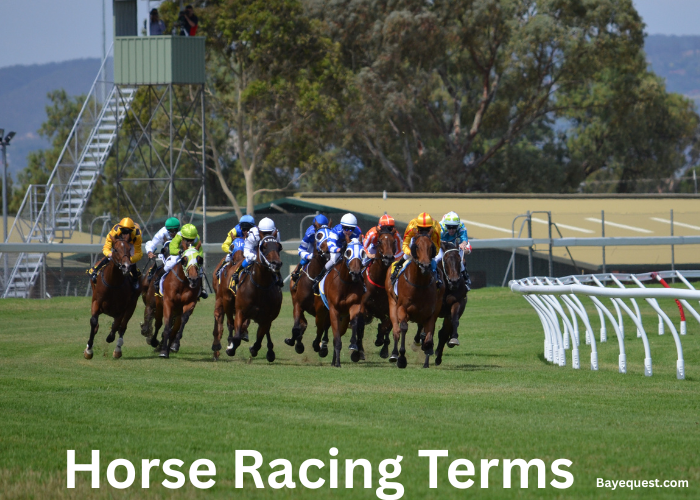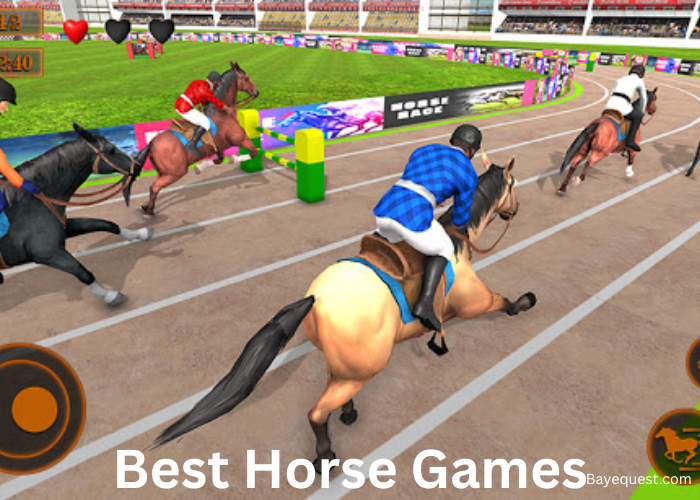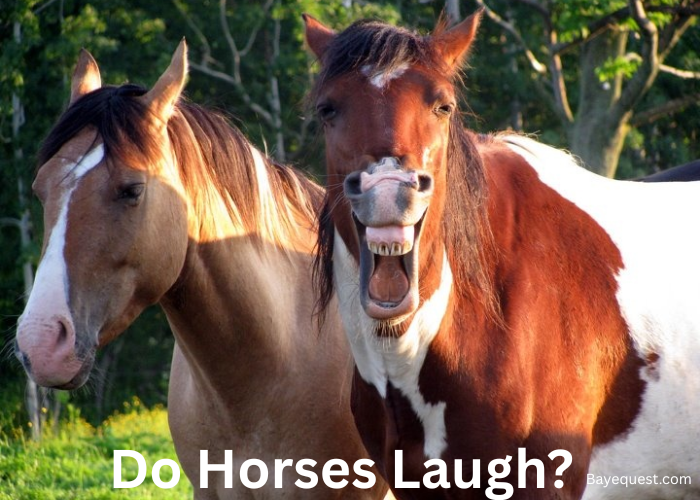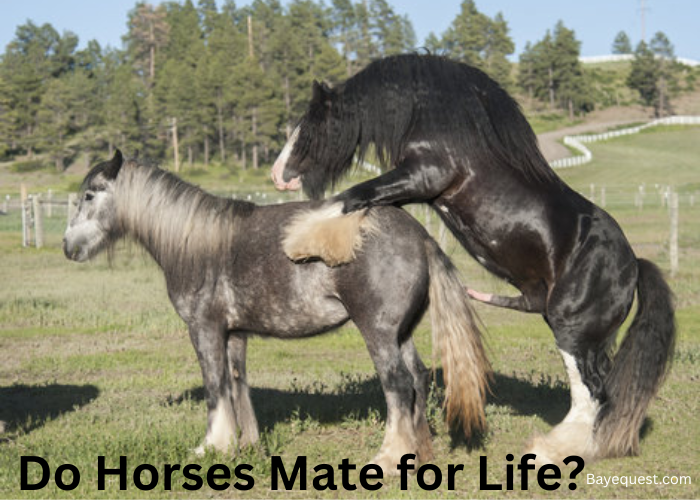Whether you’re standing trackside at Cheltenham or watching the Kentucky Derby from your sofa, there’s a common theme at every horse racing event – racing lingo.
Some of it sounds poetic (“on the bridle”), some sounds mysterious (“drawn wide”), and some, frankly, like code from a secret club.
But do you understand anything?
If not, this guide breaks it all down. No jargon for jargon’s sake – just clear, plain-English explanations, real examples, and the occasional tip to help you sound like a seasoned racegoer. We even cover racecard lingo so you can follow every furlong of action.
Let’s start with the basics.
Horse Racing Terms: Key Takeaway
- Thoroughbred – the main racing breed.
- Jockey – the rider in a race.
- Trainer – prepares the horse for racing.
- Owner – pays for and manages the horse.
- Stewards – officials who enforce race rules.
- Rail – the inside boundary of the track.
- Paddock / Parade Ring – where horses are shown before a race.
- Starting Gate / Stalls – where flat races begin.
- Furlong – a traditional race distance unit.
- Going / Track Condition – describes how firm or soft the surface is.
- Maiden Race – for horses that have never won.
- Claiming Race – where horses can be bought for a set price.
- Handicap Race – horses carry different weights to even the field.
- Stakes Race (Grade/Group 1) – the highest class of races.
- Post Position / Draw – horse’s starting stall number.
- Form Figures – past finishing positions shown on a racecard.
- Front-runner – a horse that likes to lead early.
- Closer – a horse that finishes strongly from behind.
- Photo Finish – used to decide very close races.
- On the Bridle – horse running easily without effort.
Core Race-Day Roles and Participants Terms
In every race, an elaborate team – human and equine – works together to make the event a success. Knowing who does what will make the whole experience far easier to follow.
Horse
At the centre is, of course, the horse. In most professional races, this is a Thoroughbred, a breed developed for speed and stamina.
It’s worth noting that “Thoroughbred” is a specific breed, while “purebred” simply means any horse with unmixed ancestry.
Owner
The owner is the person or partnership who buys and maintains the horse. They pay for training, stabling, vet bills, and travel. Owners share the prize money.
Trainer
Next is the trainer, who oversees the horse’s fitness, diet, and racing schedule. A good trainer knows how to place a horse in races where it has the best chance of success.
Jockey
The jockey is the rider during the race. An apprentice (UK) or bug boy/girl (US) is a developing jockey who receives a weight allowance, meaning their mount carries less weight to encourage trainers to hire them.
Stable staff
Stable staff, including grooms, exercise riders, and yard hands, handle the horse’s day-to-day care and often form strong bonds with the animals.
Stewards
Finally, stewards are the officials who ensure that races are run fairly, investigate any interference, and enforce the rules of racing.
Together, this network of people and horses is what you see on race day. Understanding their roles gives you a much deeper appreciation of what happens beyond the finish line.
Track, Distances, and Surfaces Horse Terms
No two racecourses are exactly alike. The track itself varies a lot and can have a huge effect on how a race unfolds.
Rail
The rail is the inside barrier marking the course’s boundary. Horses closest to the rail run the shortest distance, but position alone doesn’t guarantee success.
Sometimes the inside is slower if the ground is worn.
Paddock
Before the start, you might see horses in the parade ring GB) or paddock US). This is where they are saddled and paraded so connections, punters, and officials can get a final look at their condition and behaviour.
Starting gate
Most flat races start from starting stalls (UK) or a starting gate (US). These are metal frames with individual stalls that open simultaneously. Jump races often use a tape start or flag start instead.
Furlong
Race distances are traditionally measured in furlongs. One furlong equals one-eighth of a mile (220 yards or ~201 metres). A five-furlong race is a sharp sprint; two miles or more is for stayers with great stamina. In metric countries, metres are used instead.
Track condition
The going (GB) or track condition (US) describes the firmness of the surface. In the UK, the official scale runs from Heavy (waterlogged) through Soft, Good to Soft, Good, Good to Firm, to Firm (hard ground).
In the US, dirt tracks are rated Fast, Good, Sloppy, or Muddy, while turf courses use Firm, Good, Yielding, or Soft.
Surfaces vary as follows:
- Turf – Natural grass; common worldwide.
- Dirt – Favoured in North America for speed.
- Synthetic – Man-made blends (e.g., Polytrack, Tapeta) designed for consistency and safety.
Understanding a track’s layout, surface, and going helps explain why certain horses thrive in some conditions but struggle in others.
Race Types and Classes Terms
Not all horse races are created equal. In fact, racing is organised into a hierarchy of types and classes to match horses of similar ability. This helps maintain competitive fields and fair betting markets.
Maiden races
At the entry level are maiden races, designed for horses that have never won. These give inexperienced runners a fair shot at breaking their “duck.”
In jumps racing, there’s a similar concept for novice hurdlers or chasers.
Allowance races
In the US, allowance races are a step up. They have specific entry conditions, often based on how much a horse has won in the past.
This keeps competition balanced without putting horses up for sale.
Claiming races
Claiming races are unique because every horse entered can be bought (“claimed”) for a set price. This levels the field financially and encourages new owners to enter the sport.
There’s also a hybrid version called optional claiming – a mix of allowance and claiming conditions.
Handicap races
Handicap races assign each horse a specific weight to carry, based on its official rating or past performance. The goal is to give every runner, in theory, an equal chance of winning.
Top-rated horses carry the most weight; lower-rated ones carry less.
Stakes races
At the top are stakes races – high-prestige contests with bigger purses. In the UK, these are called Group races (Group 1 being the highest), while in the US, they are graded stakes (Grade 1 at the top).
These are where champions and future stallions prove themselves. Beneath these are listed races, a notch below group/graded level, but still prestigious.
Selling races
In the UK and Ireland, you’ll also find selling races, where the winning horse is auctioned immediately after the race.
Knowing a race’s type and class gives vital context: a win in a Grade 1 is far more impressive – and valuable – than a maiden win at a small track.
Entries, Fields, and Post Positions Terms
Every race starts with a field – the group of horses entered to compete. Understanding how entries work can help you spot important details before betting.
Post position
The draw (GB) or post position (US) is the number assigned to a horse’s starting stall. This is determined randomly (often by a public draw) and can influence tactics.
On some tracks, an inside draw is an advantage; on others, it might mean getting boxed in.
Entries
Declarations (UK/Ireland) or entries (US) are the official announcements that a horse is set to run. Final declarations often occur 24-48 hours before the race.
Also-eligible
An also-eligible (US) horse is on standby and can run only if another horse is withdrawn. In the UK, the term reserve is used similarly.
Scratch
A scratch (US) or non-runner (GB) is a horse withdrawn before the race begins. Reasons can include injury, unsuitable going, or transport issues.
Coupled entries
Coupled entries occur in some US betting markets, where two horses from the same owner or trainer are treated as a single betting option. If one wins, your bet wins.
Pacemaker
Finally, you may see a pacemaker – a horse deliberately entered to set a fast early pace, usually to benefit a stablemate with strong finishing speed.
These pre-race details often hold valuable clues about strategy and race shape before the gates even open.
The Horse Form Guide and How to Read It
A racecard (UK) or past performances / PPs (US) is your map to understanding a race before it’s run. Here’s how to break it down:
Horse’s name and details
- Lists the name, age, sex, and sometimes colour.
- It is also worth noting the sire (father) and dam (mother), as this can hint at suitability for certain distances or surfaces.
Form figures
- A string of numbers/letters showing recent finishing positions.
- Example: 3-121 = 3rd, 1st, 2nd, 1st in the last four runs.
- Letters can indicate other outcomes: P (pulled up), F (fell), UR (unseated rider).
Class
- Tells you the race level (maiden, handicap, stakes, etc.).
- Moving up or down in class can strongly affect performance.
Weight carried
- In the UK: shown in stones/pounds (e.g., 9st 5lb).
- In the US: shown in pounds only (e.g., 129 lb).
- Includes jockey’s weight plus saddle and gear.
Draw / Post position
- Stall number for starting position.
- Certain draws may be advantageous on specific tracks.
Speed ratings
- Beyer Speed Figures (US); Racing Post Ratings or Topspeed (GB).
- Higher numbers indicate faster performances relative to conditions.
Official rating/OR (GB)
- A number assigned by the handicapper to assess ability; used to set weights in handicaps.
Equipment notes
- Blinkers, cheekpieces, visor, tongue tie, hood, etc.
- “1st time” means the horse is trying the equipment for the first time, can be a key angle.
Trainer and jockey
- Useful for spotting in-form stables or jockey-trainer partnerships with high strike rates.
Course and distance wins
- Often marked as “C” (course winner), “D” (distance winner), or “CD” (won over course and distance).
Pro tip: Pick one or two races and practise reading the form line-by-line before betting. You’ll start to see patterns in what winners tend to have in common.
Running Styles, Splits, and Margins Terms
Understanding how a horse runs, and how race distances are measured, is key to interpreting results and predicting future performance.
These terms describe movement patterns, timing breakdowns, and the way margins are recorded in horse racing.
Front-runner
A horse that likes to set the pace right from the start. These runners often try to control the tempo and can be hard to catch if left unchallenged.
Closer
A horse that prefers to settle near the back early on, then makes a strong late run in the final stages. Closer success often depends on a fast early pace tiring out the leaders.
Fractions / Sectionals
The times recorded for specific segments of a race. In the US, they’re often called “fractions” and given at set distances (e.g., quarter-mile splits). In the UK, “sectionals” are used more commonly.
Making all
When a horse leads from start to finish without losing the top spot. Often the mark of a front-runner with stamina and good pace control.
Photo finish
Used when the finish is too close to call by eye. A high-speed camera at the line determines the official order of finish.
Lengths
The standard measurement for the distance between horses at the finish – roughly the length of a horse from nose to tail. Other close margins include “short head” (extremely narrow) and “nose” (barely a margin at all).
Pulled up
When a jockey stops the horse before finishing, often due to injury, fatigue, or a lost chance of winning.
Eased
A horse that finishes the race without being pushed hard by the jockey. This often happens when victory is certain or the horse is beaten and the rider wants to preserve energy.
Jockey Tactics and Race Riding Terms
The way a jockey rides can make the difference between winning and losing, even on the best horse. These terms cover common strategies, riding styles, and in-race maneuvers that can influence the outcome.
Held up
A tactic where the jockey deliberately keeps the horse near the back early on to conserve energy for a strong late run.
Tracking
Positioning the horse just behind the leaders to avoid setting the pace but staying close enough to strike when the time is right.
Boxed in
When a horse is trapped between other runners with no clear path forward, limiting its ability to accelerate.
Switching out / Angling out
Moving the horse to the outside of the pack to find a clear run toward the finish. Often used when boxed in or blocked.
Asking for an effort
The moment a jockey begins urging the horse to run faster, typically using hands, heels, or whip encouragement.
Driving finish
A strong, sustained push from the jockey in the closing stages to get every last ounce of effort from the horse.
Hands and heels
A riding style where the jockey avoids using the whip and instead urges the horse forward using only hands and leg pressure.
Over the top
Describes a horse that peaks too soon during a season or campaign and shows signs of fatigue, often due to over-racing.
Slang and Commentary You’ll Hear
Horse racing has a colorful vocabulary that you’ll often hear from commentators, punters, and racing fans. These expressions add excitement to the sport, even if they aren’t “official” terms.
- Across the board: A bet covering win, place, and show on the same horse – often used casually to mean betting in multiple ways.
- Banker: A horse considered almost certain to win, often forming the cornerstone of multiple bets.
- Blew up: When a horse fades badly after setting a strong early pace, often due to running out of stamina.
- Bolted: A horse that runs uncontrollably, either before the start or during the race, usually wasting its chances.
- Broke maiden: When a horse wins for the first time after several attempts.
- Hang on for dear life: A commentator’s phrase for when a tiring leader is just barely holding off challengers at the finish.
- On the bridle: A horse traveling easily without being pushed by the jockey, usually indicating it has more to give.
- Shot out of the gates: Describes a horse with a very quick start, often gaining an early advantage.
- Under the pump: An expression meaning the jockey is pushing hard to get the horse to respond – similar to “all-out.”
- Walk in the park: A very easy win, often by a large margin with little effort required.
Horse Racing Terms: FAQs
Why are there so many specialized terms in horse racing?
Horse racing is a centuries-old sport with traditions from multiple countries. Over time, different regions developed their own slang, jargon, and technical terms to describe betting, track conditions, race types, and horse behavior.
Are US and UK racing terms interchangeable?
Not always. While some concepts are similar, many terms differ or have different meanings. For example, “furlong” is common in both, but a “claiming race” in the US is called a “selling race” in the UK.
What’s the best way to remember these terms?
Start with the basics you hear most often, like “maiden,” “going,” and “purse.” Watching live races or replays with commentary helps reinforce their meaning in context.
Do commentators always use official terms?
No. Racing commentary often mixes official terminology with colorful slang to make the broadcast more engaging. Phrases like “under the pump” or “hung on for dear life” aren’t official but add excitement.
Are racing terms the same for flat racing and jump racing?
Some are, but others are specific. For example, “hurdle” and “steeplechase” apply only to jump racing, while “furlong” and “purse” apply to all race types.
How important is it to know betting terms if I’m only watching for fun?
It’s not essential. But knowing a few betting terms like “each-way” or “across the board” can make the experience more interesting – especially when following the action.
Horse Racing Terms: Conclusion
Horse racing has a language of its own. Whether you’re a first-time spectator or a seasoned racegoer, understanding the terms adds depth to every stride, jump, and photo finish.
So next time you’re at the track or tuning in, you’ll not only know what’s happening — you’ll be speaking the sport’s language like a pro.








